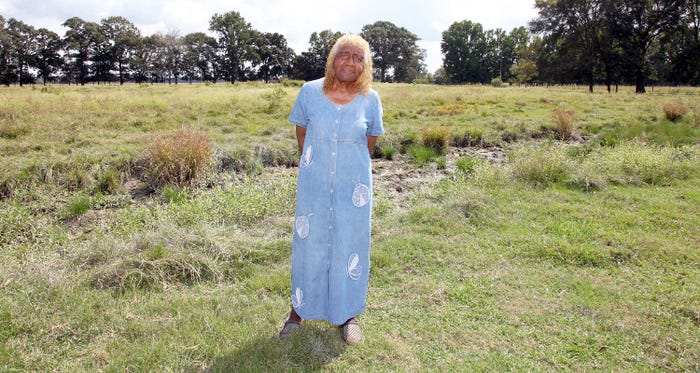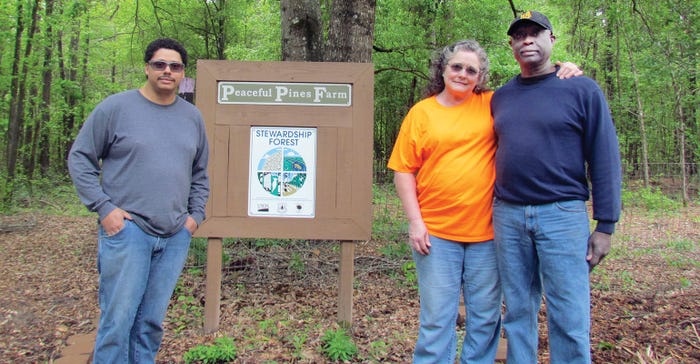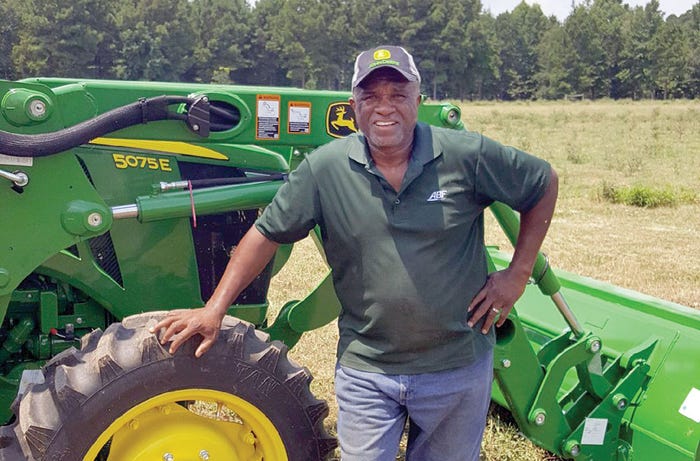June 14, 2018

Cost-share assistance funded through the Environmental Quality Incentive Program (EQIP) can go a long way in bringing the farm operations of small producers in Arkansas from good to great, says Dr. Henry English, head of the Small Farm Program at the University of Arkansas at Pine Bluff. In some cases, access to assistance has helped small farmers keep their family farm in business.
English said EQIP provides financial assistance to help producers install conservation practices in areas such as improving irrigation efficiency, promoting soil health or restoring pastureland on their farm or ranch.
“EQIP funds allow farmers to make important changes to their land that could otherwise be financially infeasible,” he said. “Improvements offered through the program range from the addition of wells for irrigation and watering livestock, underground pipelines or cross fencing, to the implementation of organic pest and weed management practices. The broad possibilities all depend on a farmer’s individual goals and the willingness to improve the sustainability of a piece of land.”
Administered by USDA’s Natural Resources Conservation Service, EQIP enables producers to implement structural, vegetative or management practices that improve natural resources at the farm level. NRCS provides financial cost-share and technical assistance to help producers improve the efficiency of their operations on eligible land including cropland, rangeland, pastureland, non-industrial private forestland and other farm or ranch lands.
EQIP often shares up to 90 percent of project costs for conservation practices implemented by socially disadvantaged, limited-resource, beginning and veteran farmers and ranchers, English said. These producers are also eligible to receive up to 50 percent advance payment for purchasing materials or contracting services to begin the installation of approved conservation practices.
“The Small Farm Program at UAPB works with small producers in Arkansas to understand their operations, short and long terms goals and areas for improvement on their land,” he said. “We then connect the farmers with local NRCS personnel who can assist in applying for EQIP funds.”
In February 2017, the UAPB Small Farm Program won the NRCS Partnership Award for its role in increasing the participation rate of historically underserved producers in conservation programs by almost 70 percent in the last five years. During this time, the program has helped these producers obtain over $6 million in funding to enhance their farm operations.
“The feedback we have received from small producers in Arkansas has been very positive,” English said. “In several cases, the funding they received allowed them to take on new projects and increase their profitability.”
Improving pastureland in Chicot County
Ms. Sarah Butler, 89, raises cattle, chickens, ducks, turkeys and rabbits on the 40-acre farm in Chicot County she has managed since 1989. When she met with an Extension agent from the Small Farm Program, she asked about ways to improve the surface quality of her pastureland and livestock watering facilities.
Butler received an EQIP contract for a number of conservation practices that will improve the state of her farm. First, she was able to implement a rotational grazing program between the different fields on her farm to maximize livestock production and reduce sediment and nutrient runoff.

Sarah Butler received an EQIP contract to implement a rotational grazing program and reduce sediment and nutrient runoff on her 40-acre farm. She says the improved pastureland has put more weight on her cattle, which helps supplement her income.
EQIP funding also covered the cost of new irrigation facilities, including a well, trough and underground piping. NRCS heavy use area protection was put in place to stabilize the ground surfaces around the water facilities that are frequently used by livestock. Additionally, Butler received funding for cross fencing and cover for a new access road.
“Without the NRCS cost-share program, I would not have been able to do these projects,” she said. “This program has improved my pastureland and will help put more weight on my cattle, which will supplement my income.”
Thanks to the positive conservation practices Butler implemented on her land, she was able to enroll in the Conservation Stewardship Program (CSP), which encourages farmers to continue making goals to improve the condition of their land. She will be receiving annual CSP payments for the next five years.
Arkansas newcomers start organic farm with EQIP funds
When Kenneth and Jacqueline Carswell moved to Sulphur Springs, Ark., from their home in Florida, they were not sure how to accomplish the shared goal of developing their newly purchased land into an organic farm. By chance, Kenneth met Dameion White, Extension associate with the Small Farm Program, on a field trip with the Arkansas Master Gardeners Program.
“Not knowing that Dameion was an Extension associate for UAPB, I began telling him about my difficulties trying to get help in developing our land into a farm,” Carswell said. “Dameion took time out of his schedule to explain his position, agriculture as it relates to Jefferson County and the purpose of the Small Farm Program.”
Carswell explained his goal of founding an organic farm that relies on preventative practices for weed, insect and disease problems and improves the natural resources of the land, including soil and water quality.

EQIP funding allowed Kenneth and Jacqueline Carswell to accomplish their goal of developing newly-purchased land into an organic farm. The conservation practices they implemented, which included pasture development, establishment of a pond, fence installation and the development of a rotational grazing program, helped prepare the land for livestock production. At left is the Carswells’ son, Keith.
“Dameion elaborated on all the programs that are available to assist us in this process and provided step-by-step instructions to register my farm with the Farm Service Agency and then apply for assistance with the NRCS for help in developing the land into a farm,” he said. “Since meeting with Dameion, my family has received over $40,000 in funds from the EQIP program to improve our operation through conservation practices.”
Conservation practices including the planting of forage and biomass, pasture development, establishment of a pond, fence installation and the development of a rotational grazing program helped prepare Carswell’s land for livestock production. Other preparations for his woodland included the installation of firebreak, riparian buffers and stream crossings, as well as the introduction of pollinators and development of an integrated pest management system and forestry plan.
After transforming their land through EQIP funds, the Carswells named their operation “Peaceful Pines Farm.” They currently raise goats, chickens, fruit and vegetables and timber.
“Our dream of establishing an organic farm together would not have been possible without the help of the Small Farm Program,” he said.
Keeping the family farm in business
L.B. Taylor Jr. continues a family legacy of farming on his land in Bradley, Ark. For 10 years, he has owned the William Taylor Farm, which was originally purchased by his grandfather and later inherited by his father, L.B. Taylor.
The feat of managing over 30 head of cows and their calves proved challenging as the farm’s ponds started to dry and the quality of the pastureland began to degrade. Taylor decided to seek the advice of Extension associates at the Small Farm Program to determine the feasibility of revitalizing the farm’s pastureland and irrigation facilities.

L.B. Taylor Jr. used EQIP cost-share assistance to help restore pastureland on his family farm, which was originally purchased by his grandfather and later inherited by his father.
“If it were not for some of the EQIP assistance provided, I would have decided to stop farming years ago,” he said. “Since applying for assistance, I have received thousands of dollars in cost-share assistance through EQIP and CSP, as well as farm operation loans to help in restoring my pastureland.”
Through EQIP funds, Taylor was able to build new water facilities, install heavy use area protection around watering tanks and gated access and received recommendations on weed control.
“This program has provided great opportunities, and I have made sure to share my experience with local farmers and others from various states,” he said. “I encourage them all to seek assistance when needed, as there are programs out there that can significantly improve their farm operations.”
Enhancing a cattle farm
Since 1980, Howard Brown has raised cattle and grown hay on his farm in Chicot County, Ark. Thanks to his enrollment in the Conservation Stewardship Program, he can make continuous improvements to his cattle operation.
The CSP provides funding in five-year increments to producers to maintain their conservation practices and to add other enhancements to their operation. Brown has participated in the program five times and recently signed up for CSP funding for another five years.
“Most recently, CSP funds have helped improve my pasture with the addition of water traps and plants to attract pollinators,” he said. “Other EQIP funds allowed me to implement rotational grazing, add water lines and plant grass seeds in the pasture.”
With an EQIP contract, Brown also installed a water trough for his cattle after the pasture was divided into multiple sections with cross fencing. He then added a well and underground water lines to supply water to the trough. After installing the new irrigation equipment, he implemented heavy use area protections by placing gravel around the water trough to prevent erosion and the buildup of a muddy area due to increased hoof traffic in the area.
About the Author(s)
You May Also Like




